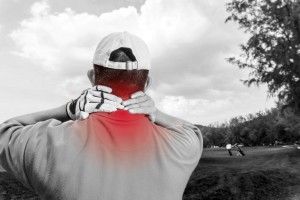Common Neck Injuries Sustained in Sports
 For obvious reasons, you don’t want a neck injury. Not only have many professional athletes sat out whole seasons – or ended their careers – due to necks injuries, but roughly 10 percent of the adult population suffers from stiff, painful necks at any time, impacting their comfort and quality of life.
For obvious reasons, you don’t want a neck injury. Not only have many professional athletes sat out whole seasons – or ended their careers – due to necks injuries, but roughly 10 percent of the adult population suffers from stiff, painful necks at any time, impacting their comfort and quality of life.
Working out your shoulders and back, high-impact training like jumping and falling and even just sitting or sleeping improperly can cause problems with your neck. If you want a strong, stable neck, you should know about these common neck disorders – and how to avoid them.
Nerve Problems
The neck is the thinnest part of your body – and it is also where some of the most important nerves in your body reside. Thus, damage to the neck can easily result in nerve problems that result in numbness, reduced function, pain or other issues on other parts of your body. It is possible to develop a pinched nerve in the neck merely by sleeping wrong or turning your head quickly and improperly, but in sports, more serious nerve issues can occur.
Among the worst are stingers and burners, which often occur to football players and other contact-sport athletes. As their name suggests, stingers and burners result in stinging, burning pain as well as an electrical sensation down the arm. When these symptoms last more than a minute or two, it is critical that you see a doctor as you may have a catastrophic neck injury.
Muscle Spasms
Muscle spasms occur in any skeletal muscles that have recently been overused and are feeling fatigued. Dehydration and malnutrition can also result in uncomfortable or painful spasms. High-performance athletes in any sport can suffer spasms, but the solution is simple: rest, hydrate, eat healthily and rest more.
Strains and Sprains
The average joe uses the terms “strain” and “sprain” relatively interchangeably, but each describes a unique type of injury, regardless of where the strain or sprain occurs. Knowing the difference can help you find relief faster and get back to the sports activities you love.
A neck strain concerns overuse of the muscles that move the head and upper part of the spine. You might feel stiffness in addition to pain, but usually strains will heal within a week with rest or modified activity as well as over-the-counter pain medication.
Meanwhile, sprains are injuries to the ligaments, which are connective tissues that bind the bones. Sprain pain often worsens during the 24-hour period after injury, can come with a headache and numbness or weakness in your neck, shoulder and arms. Rest and ice is the most common treatment, but more severe sprains could require surgery.
Golfers, tennis players and athletes that often perform sudden twists or stretches with their cervical spine often succumb to strains and sprains. Both strains and sprains can be mild or serious, so it is a good idea to visit with a physician if the pain doesn’t fade after a few days.
Herniated Disc
Between each of your vertebrae all the way up and down your spine are discs, which cushion the bones and provide greater flexibility in the back. These discs can rupture and form a hernia, which often rests on your nerves and creates intense pain, weakness, numbness and burning sensations. If you herniate a disc in your neck, it’s likely you’ll feel similar sensations in one or both arms.
Tears in cervical discs can occur one of two ways: through a sudden, forceful stress or repeated stress to the neck joint. Treatment for this injury isn’t quick and easy; it requires weeks or months of rest and physical therapy, and some sufferers do require surgery. Many athletes with this neck issue must retire from their sport.
Dislocation and Fracture
 Perhaps the most traumatic injuries of all, dislocations and fractures of the cervical vertebrae are catastrophic – but they are also relatively rare. When a neck bone moves out of its normal position, it creates instability; most often, it will lock into place in the wrong position, rupturing ligaments and doing damage to the spinal cord. Often, dislocations are accompanied by fractures because only intense traumas to the neck can cause vertebrae to jump.
Perhaps the most traumatic injuries of all, dislocations and fractures of the cervical vertebrae are catastrophic – but they are also relatively rare. When a neck bone moves out of its normal position, it creates instability; most often, it will lock into place in the wrong position, rupturing ligaments and doing damage to the spinal cord. Often, dislocations are accompanied by fractures because only intense traumas to the neck can cause vertebrae to jump.
Surgery is undoubtedly necessary for both dislocation and fracture, so doctors can accurately assess damage and repair soft tissues that might be affected. You might be forced to rest for months, or else wear a restrictive brace non-stop. Even then, it is likely that you will have severe consequences, perhaps including paralysis of some parts of your body.
Neck injuries can be serious, but they can also be treated effectively. If you are experiencing any type of neck pain associated with physical activity, you should talk to your doctor to determine the best path to healing for you.